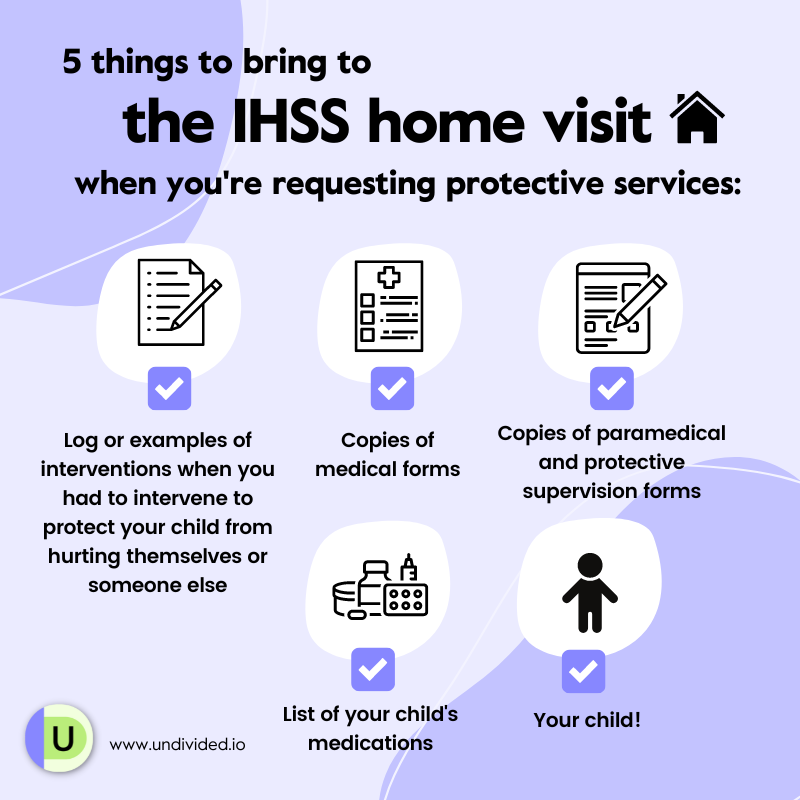
You and your child will be interviewed in your home to determine eligibility and need for In-Home Supportive Services (IHSS). Based on the information they gather, IHSS will assess the types of services needed and the number of hours they’ll authorize for each service. This assessment will include information given by you and, if appropriate, by your family, friends, physician, or other licensed healthcare professional. Learn about what you need to know before, during, and after the in-home visit here.
After you submit your initial paperwork, you will receive a notice from IHSS including the time and date of your in-home visit, along with a list of any documentation you will need to provide during the visit. This may include medical documentation, copies of assessments, and identification and proof of eligibility to work in the United States, if you plan to be your child’s provider.
Your child must be present for the visit. If you and your child are unavailable during the time slot assigned by IHSS, you must notify the caseworker as soon as possible to set a new appointment. If you are not home when the caseworker arrives, your application will likely be denied.
For further in-depth reading on preparing for the caseworker’s home visit, see Disability Rights California’s publication “IHSS Self-Assessment and Fair Hearing Guide.” Be aware that this guide is meant for both children and adults, so some services may not be applicable.

IHSS uses a “functional index ranking” to determine age-appropriate skills based on the Adapted Vineland Social Maturity Scale. The caseworker will interview you about your child’s self-care skills in the areas listed on this chart, so it may be useful to review it in advance and think about your child’s age and skill level for each self-care task that a typically developing child would be expected to perform independently. Although this chart uses numeric ranking, your caseworker will not ask you to rank your child’s skills on that basis; you should be prepared to discuss them qualitatively by describing what your child can and cannot do.
You can hear an explanation of the functional index ranking in this clip from Undivided's Public Benefits Specialist, Lisa Concoff Kronbeck:
You may also wish to provide the caseworker with copies of your child’s ABA assessments, Individualized Program Plan (IPP), and/or Individualized Education Plan (IEP), if you think they will be beneficial to your child’s case.
If you know that you will be applying for protective supervision and/or paramedical services, you may want to have these documents already prepared for the caseworker, along with documentation of need. If you are requesting paramedical services, the caseworker may visit your home again with a nurse from IHSS to go over the specific services on the form.
You should also be prepared to fill out additional forms when the caseworker arrives. Some common documents you may be asked to fill out include:
After your child’s home visit, you should gather and submit any additional documentation that you and the caseworker have discussed. This may include further medical documentation, or protective services and paramedical supervision forms and documentation if you did not have them already prepared for the home visit.
As we mentioned in our article about the application process, the IHSS office usually will not let you know if required documentation is missing or lost; they will often simply issue a denial letter or neglect to award hours for the service (for example, if the protective supervision documentation is missing).
To ensure a smooth application process, confirm that IHSS received all paperwork submitted on your child’s behalf, including documentation and forms submitted by medical providers. Have your child’s case number available whenever you call to confirm receipt of documents. Repeat this step every time you submit a new batch of documents.
Tip: Keep copies of everything you submit, along with the date you submitted the documents. You should also ask your doctor to provide you with a copy of any documents they send to IHSS, should anything need to be resubmitted.